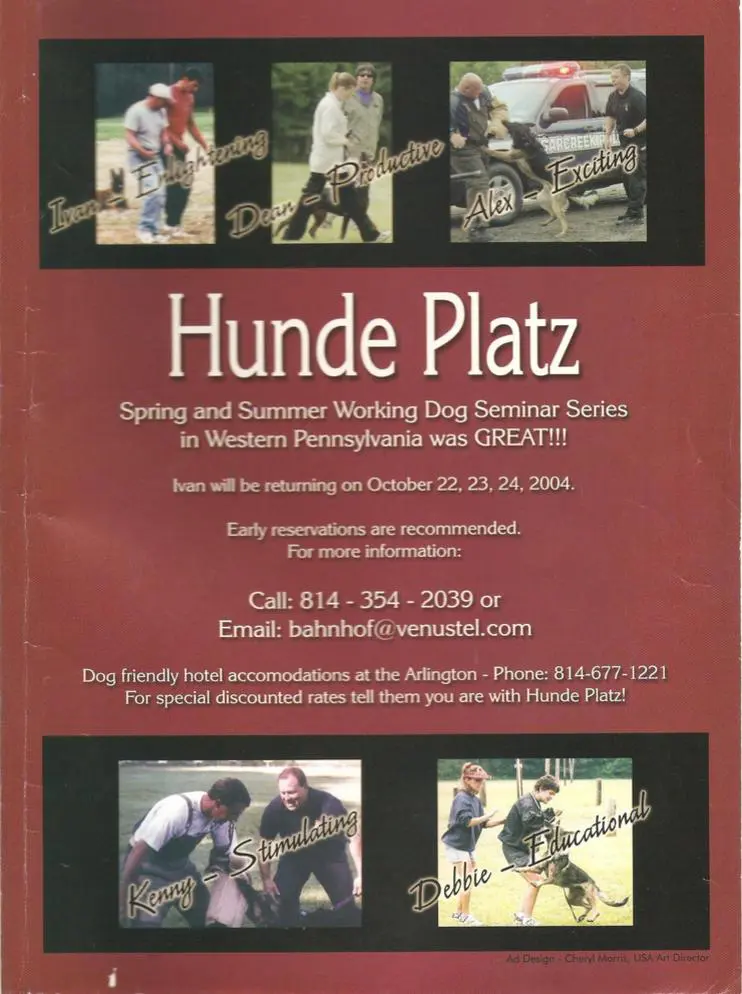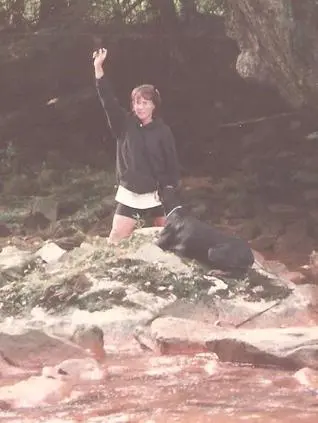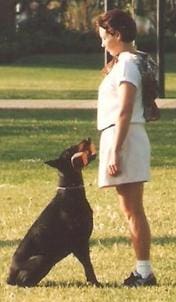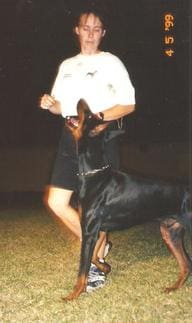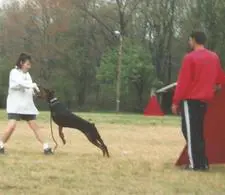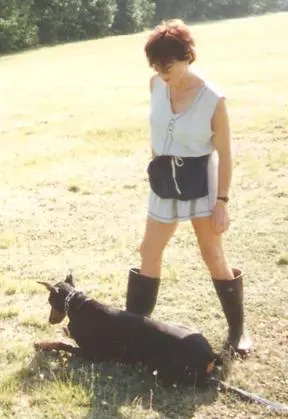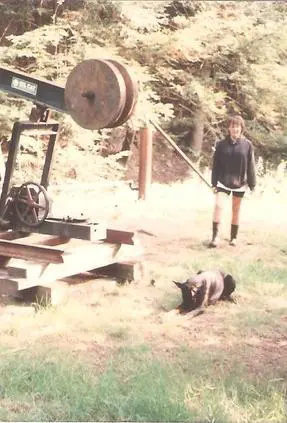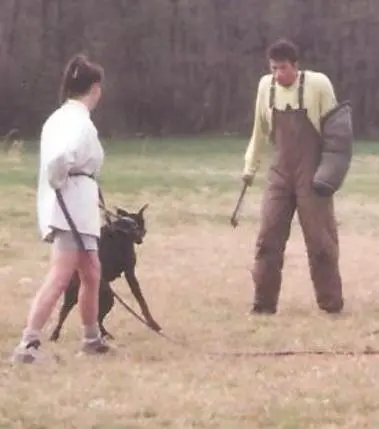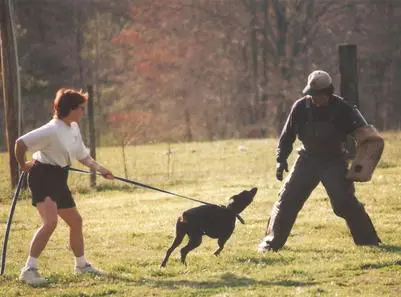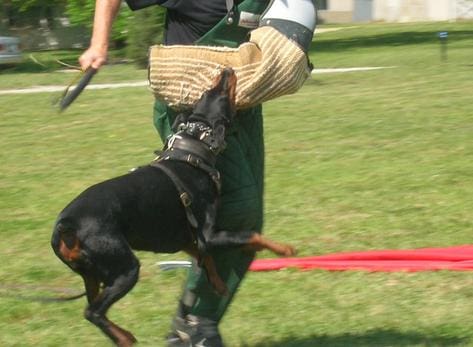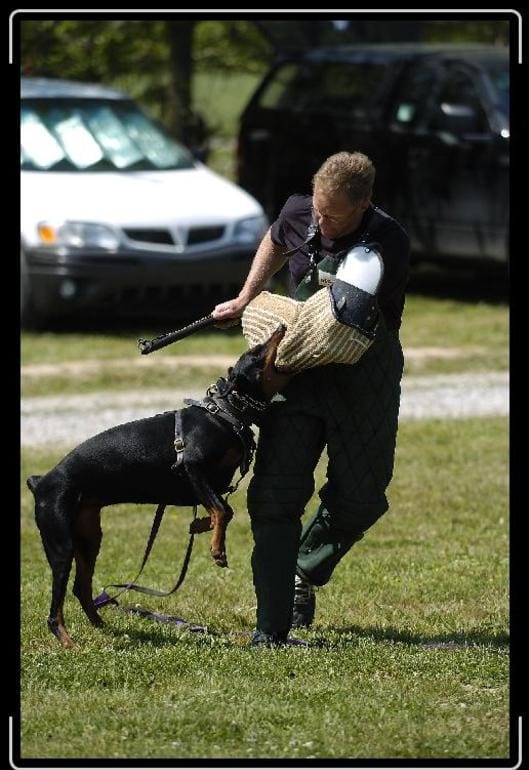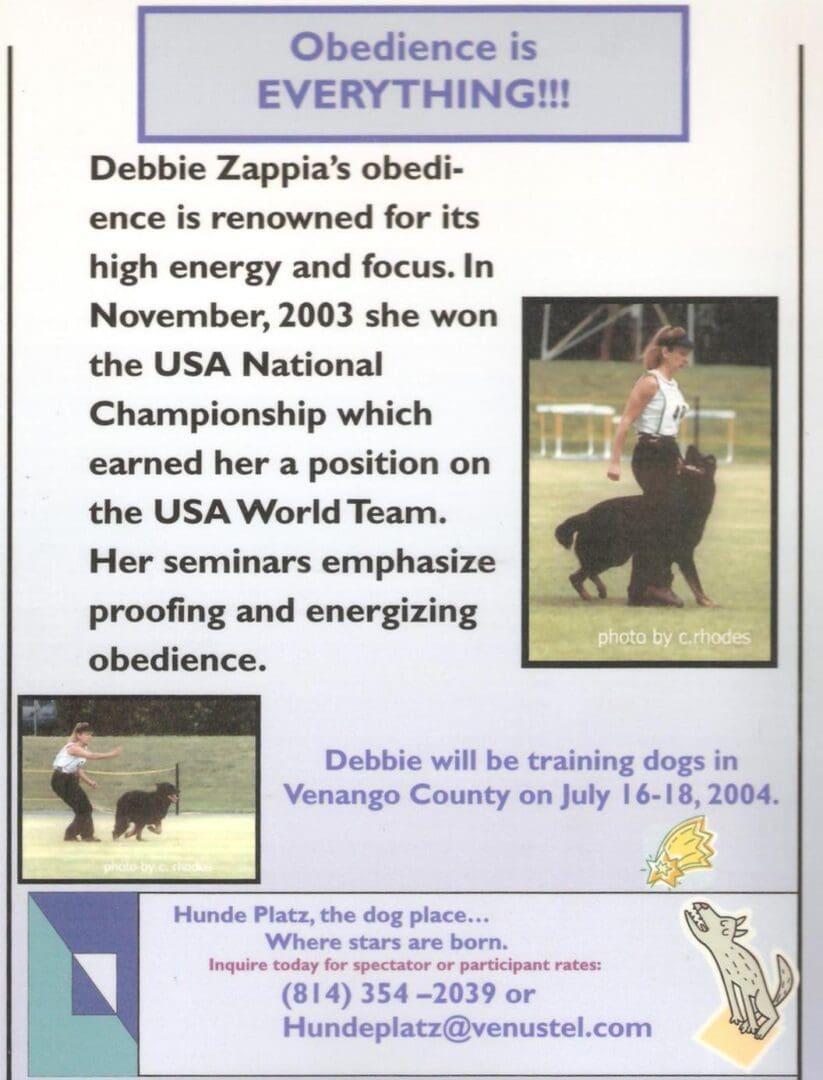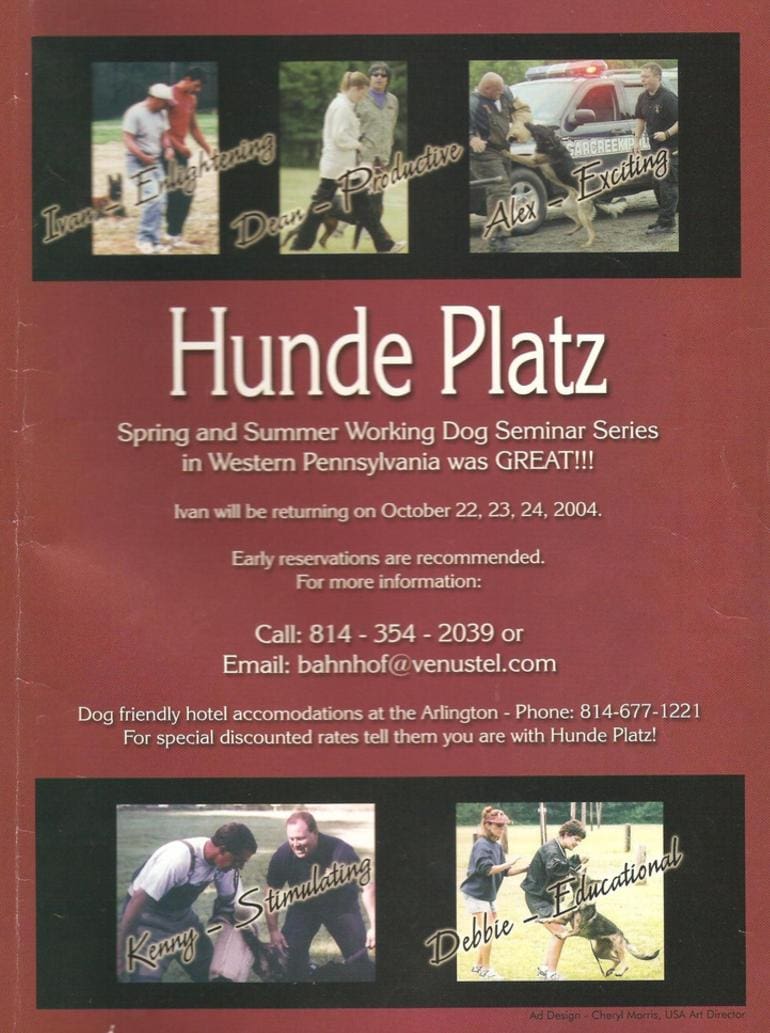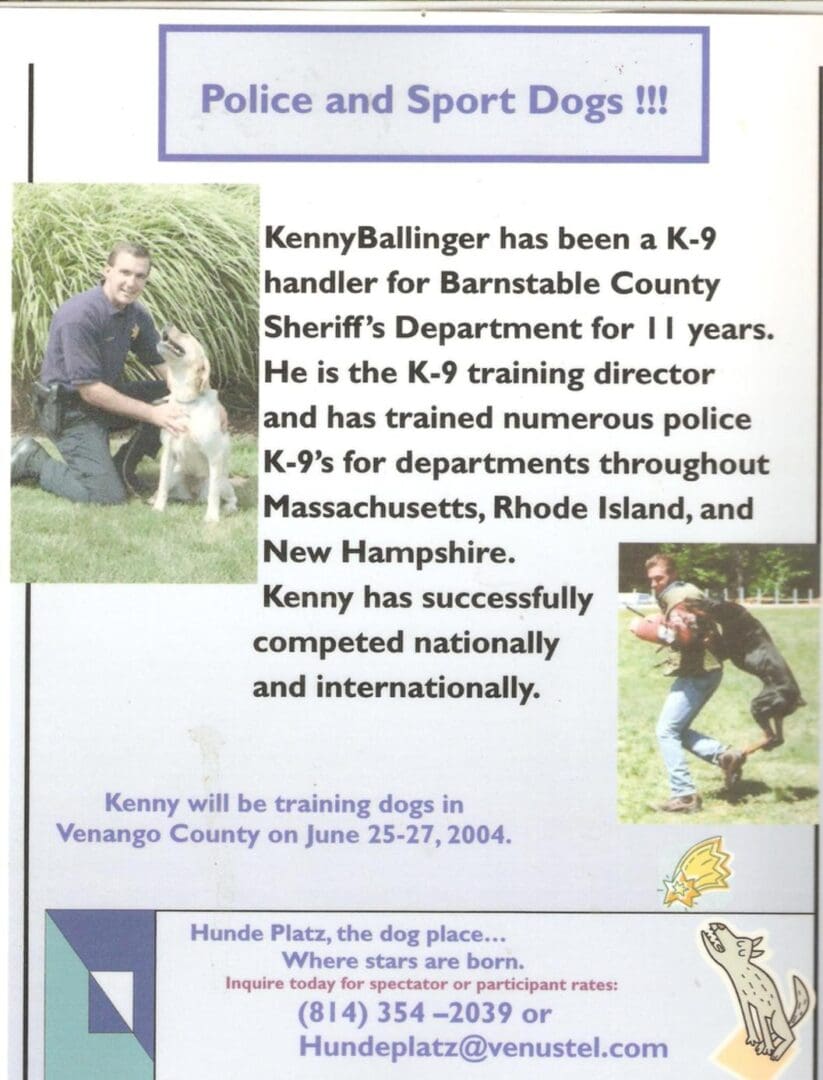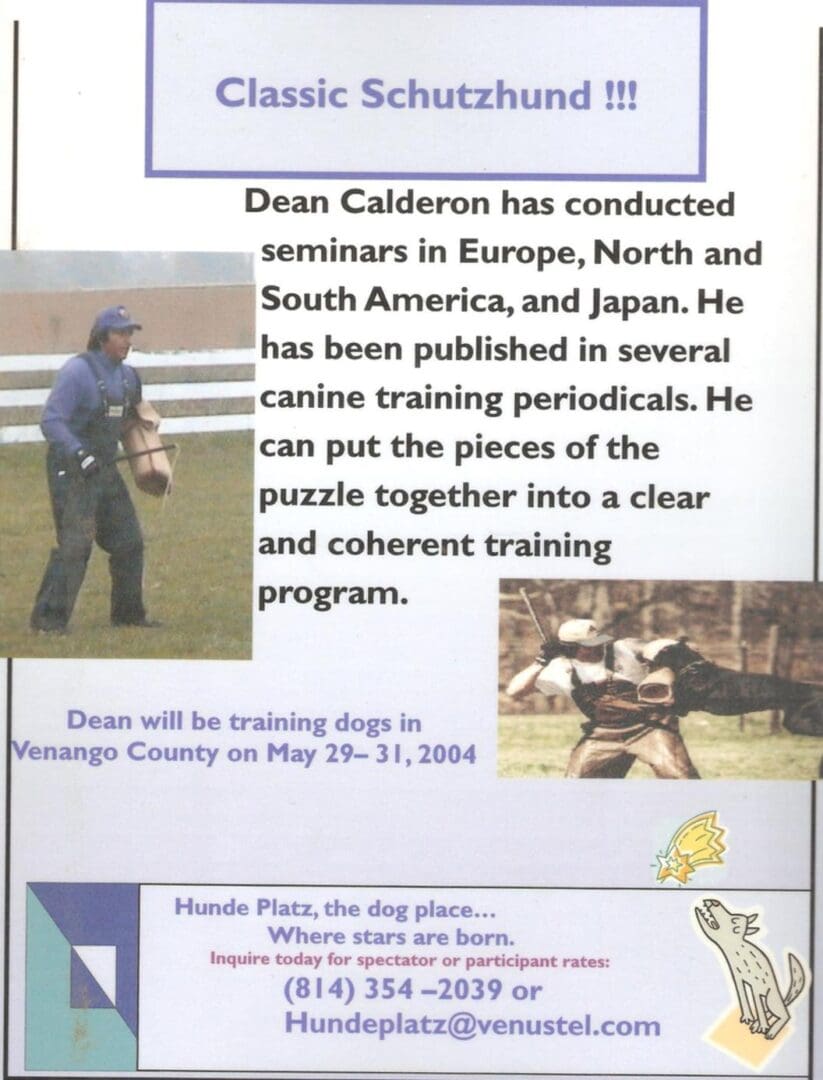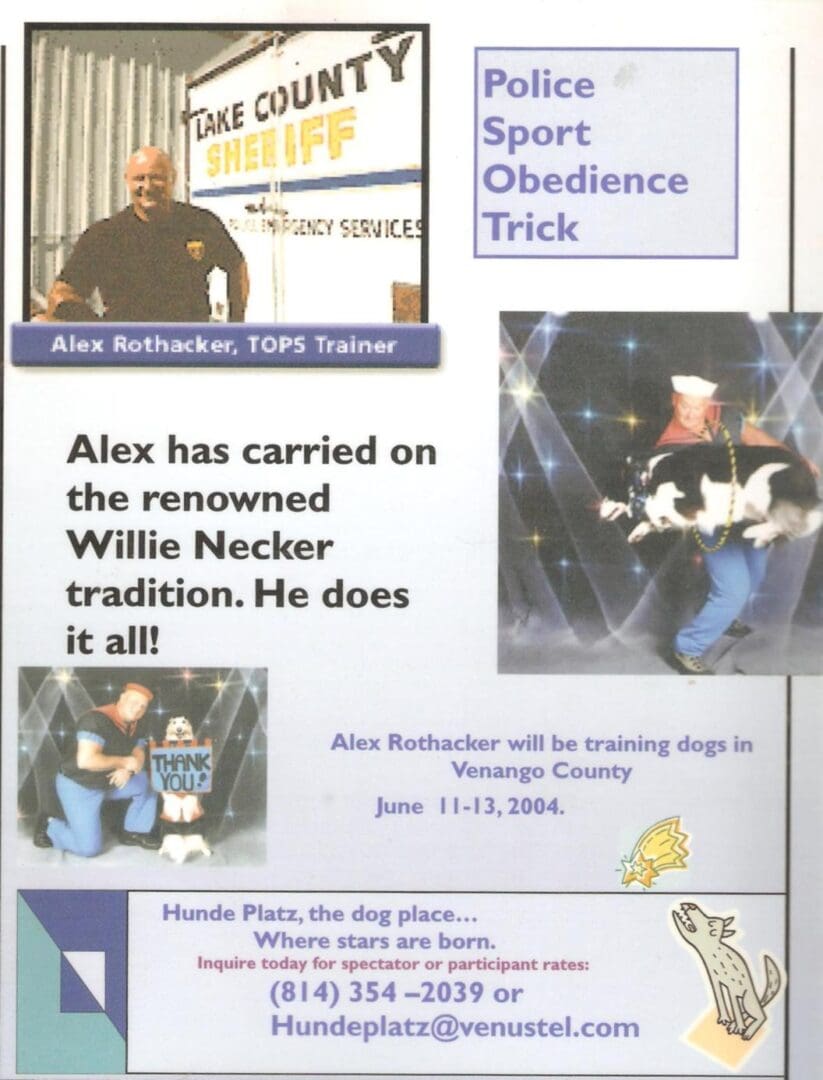Bahnhof Dobermanns:
Training Considerations.

Obedience
Obedience is the cornerstone of everything you do with your dog. If you don't have obedience, you don't have anything. People try to put obedience into two camps: Positive Training Techniques and Negative (or Compulsive) Training Techniques. Volumes have been written about pros and cons of the two approaches. In reality, neither approach works by itself. I've found that mostly positive, with very limited compulsive techniques work best for Bahnhof Dobermans.
The original works by William Koehler are very compulsive (Obedience, Tracking, Protection). Karen Pryor is known for being a proponent of positive methods. I highly recommend her books, Don't Shoot the Dog and Reaching the Animal Mind. I've read all of these books, Koehler's and Pryor's works, and many more on training dogs. Additionally, I've worked with many world class trainers. The successful trainers base their training on positive methods. The honest trainers admit to using limited compulsion with their dogs, even if their base is positive.
Some breeds like Rhodesian Ridgbacks shut down when compulsion is used.
I've found the best thing to do when training my dogs is to start with food. Food is calming. It allows for precision and does not get the dog too "amped up." Once the dog knows an exercise, then a toy can be used, which if done correctly, does not lose the precision that the dog learned when food was used. Toys, with Bahnhof Dobermans, are so motivating, that precision is difficult during early stages of learning. Start with food and transition to a toy for motivation.
Additionally, regarding negative (compulsive) techniques, I don't stick my hand in flames, walk in front of speeding trucks, or jump off cliffs. Why? I know hot things burn me. I know stepping in front of big, moving things hurts. I know that falling hurts. Dogs, when in pursuit of a rabbit or just running around sniffing, can miss the fact that an oncoming truck is speeding toward them. Thus, for them to learn that certain words mean, "Watch out! Look at me right now and do as I say right now!" can save their lives. Because I love my dogs, I teach them that when a certain word is uttered, a they must pay attention to me, NOW. Thus, I use compulsive techniques in a very limited way. Such training provides the most safety for my dogs.
It is well known that people who are born with an inability to feel pain, often get killed when they are children because they do not know what situations will harm them. We feel pain for a reason: It protects us! In my opinion, to use pain to protect my dog from serious injury or death is a permissible use of force. Thus, I use VERY LIMITED use of pain in order to preserve my dogs' lives.
That being said, a steady diet of compulsion will ruin the Bahnhof Doberman. Bahnhof Dobermans love to fight, and eventually a steady diet of compulsion will be seen as conflict by the dog, which eventually becomes a fight. As this dog matures, he will become dangerous. I do not recommend using ongoing negative methods with a Bahnhof Doberman, or you will be making a phone call that you must return him because he is "too aggressive." For excellent coaching in obedience, see Ivan Balabanov's DVD's entitled Obedience without Conflict: Playing the Game.
On this same topic, alpha rolling is NOT a good idea with a Bahnhof Doberman. There is absolutely NO reason to EVER alpha roll a Bahnhof Doberman. Again, these dogs love to fight and alpha rolling just starts the fight, early. I believe it was Temple Grandin in Animals in Translation, who pointed out that people believe their dogs know that cats are not dogs and rabbits are not dogs, but somehow, don't know that people are not dogs. As she points out, this kind of thinking is absurd. Your dog knows that you are not a dog, so why would you ever put yourself into his pack structure? You control all of his resources. You do not need to alpha roll him. Use his food, his play, his time with you to manage his behavior. You do not need to insert yourself into his pack structure. Additionally, when in the studies that highlighted pack structure, the non-alpha's were waiting to become alpha. How does that translate into your household? It means when you are not watching, of if you are having a day when you appear to be "weak," such as if you are tired or injured, the beta wolf attacks you. It is not healthy to be the alpha wolf in a wolf pack.
Avatar, Calderon, and Chantilly were all returned due to being "too aggressive." By the time Calderon and Chantilly returned I had learned that positive was better. I also learned that anxiety cannot be "corrected." If you punish anxiety, the Bahnhof Doberman will only fight more.
Tracking
Tracking is the best way to bond with your dog. You can be the beloved creature who teaches him how to hunt for his food. Dogs love to use their noses to find things, especially their daily rations. A good tracking program is the best way to begin to understand how your dog perceives the world through his scent-based, olfactory worldview. Approach tracking as the window into your dog's mind and you will learn very much about his world.
Protection
Protection work is the part of schutzhund that everyone loves. It is the part in which many Dobermans show little talent. Some people say that Dobermans were designed as "up close personal protection dogs," and thus, the idea of them running down the field to bite on a courage test is difficult for them. If the dog has prey drive and offense drive, this is absolutely not true.
Again, volumes have been written on various kinds of aggression, and you can read many of them in many places. I encourage you do to so. My experience with Bahnhof Dobermans suggests that they tend to be very stable, yet have high prey and high offense drive. Most people discuss prey and defense drive. Offense and defense are different, as we all know from participating in or watching various sports.
Some trainers try to train in prey and defense. This is not an optimal situation. Prey is fun and like chasing a rabbit for the dog. Defense is fighting for your life and not fun for the dog. A good Doberman does not need to be trained in defense. He needs to have his offensive side brought out and this is NOT done in a defensive, fighting-for-his-life setting.
Let's use humans for an example. If you ask just about any human, "What would make you commit a violent act?" Most will say, "Well, if I had to defend myself, I guess I might be violent."
In dogs, if you take any dog, including the most meek dog you can think of, if you push him into a corner to the point he believes you will kill him, he WILL bite. If you grab a rabbit and he believes you will kill him, he will bite. Such aggression is defensive. A good protection dog does not need to be pushed into a corner because he is more bold and courageous than a meek dog. He has the ability to protect. A good protection dog will bite offensively.
Again, let's look at humans. When do humans act violently in an offensive manner? Take, as an example, a fellow human in the distance, acting in a way that you do not like and hurling verbal insults at you. Most of us will not run over there and punch this troublesome guy in the nose. Some of us will. Those of us who will run and punch the guy have a high offensive drive. Offense is when you are NOT backed into a corner, but you CHOOSE to go fight anyway.
A good protection dog will go bite a guy in the distance who is acting in a troublesome manner. You can see examples of this kind of offensive drive in the photos here of Ivan Balabanov, Dean Calderon, Randy Rhodes, and Jim Hill. Alex Rothacker, Kenney Ballanger, Ken White, Randy Rhodes, Gary Hanrahan, and Jim Alloway among many other good schutzhund helpers are also excellent in this form of bringing out the offensive drive in a dog bred to protect.
In schutzhund, you want a dog with prey and offense drive. If these drives are balanced, as they are in a very good working German Shepherd, you have an excellent schutzhund dog. These are the two drives Bahnhof Dobermans are known to have. They are the two drives that Bernhard Flinks saw in Elle at his seminar in Ohio and a participant described on the Leerburg Working Dog Forum.
Note that in NONE of the dogs in these protection photographs are being backed into a corner and threatened into
"defense" drive (defending his life). In each photograph, the dog is moving forward in an offensive attack.
